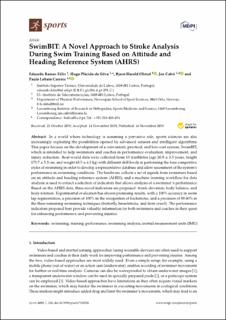SwimBIT: A Novel Approach to Stroke Analysis During Swim Training Based on Attitude and Heading Reference System (AHRS)
| dc.contributor.author | Felix, Eduardo Ramos | |
| dc.contributor.author | da Silva, Hugo Plácido | |
| dc.contributor.author | Olstad, Bjørn Harald | |
| dc.contributor.author | Cabri, Jan | |
| dc.contributor.author | Correia, Paulo Lobato | |
| dc.date.accessioned | 2020-05-12T08:53:22Z | |
| dc.date.available | 2020-05-12T08:53:22Z | |
| dc.date.created | 2020-01-10T11:14:14Z | |
| dc.date.issued | 2019 | |
| dc.identifier.citation | Sports. 2019, 7(11), 238. | en_US |
| dc.identifier.issn | 2075-4663 | |
| dc.identifier.uri | https://hdl.handle.net/11250/2654017 | |
| dc.description | This is an open access article distributed under the Creative Commons Attribution License (https://creativecommons.org/licenses/by/4.0/) which permits unrestricted use, distribution, and reproduction in any medium, provided the original work is properly cited. | en_US |
| dc.description.abstract | In a world where technology is assuming a pervasive role, sports sciences are also increasingly exploiting the possibilities opened by advanced sensors and intelligent algorithms. This paper focuses on the development of a convenient, practical, and low-cost system, SwimBIT, which is intended to help swimmers and coaches in performance evaluation, improvement, and injury reduction. Real-world data were collected from 13 triathletes (age 20.8 ± 3.5 years, height 173.7 ± 5.3 cm, and weight 63.5 ± 6.3 kg) with different skill levels in performing the four competitive styles of swimming in order to develop a representative database and allow assessment of the system’s performance in swimming conditions. The hardware collects a set of signals from swimmers based on an attitude and heading reference system (AHRS), and a machine learning workflow for data analysis is used to extract a selection of indicators that allows analysis of a swimmer’s performance. Based on the AHRS data, three novel indicators are proposed: trunk elevation, body balance, and body rotation. Experimental evaluation has shown promising results, with a 100% accuracy in swim lap segmentation, a precision of 100% in the recognition of backstroke, and a precision of 89.60% in the three remaining swimming techniques (butterfly, breaststroke, and front crawl). The performance indicators proposed here provide valuable information for both swimmers and coaches in their quest for enhancing performance and preventing injuries. | en_US |
| dc.language.iso | eng | en_US |
| dc.subject | swimming | en_US |
| dc.subject | training | en_US |
| dc.subject | performance | en_US |
| dc.subject | swimming analysis | en_US |
| dc.subject | inertial measurement units (IMU) | en_US |
| dc.title | SwimBIT: A Novel Approach to Stroke Analysis During Swim Training Based on Attitude and Heading Reference System (AHRS) | en_US |
| dc.type | Peer reviewed | en_US |
| dc.type | Journal article | en_US |
| dc.description.version | publishedVersion | en_US |
| dc.source.pagenumber | 11 | en_US |
| dc.source.volume | 7 | en_US |
| dc.source.journal | Sports | en_US |
| dc.source.issue | 11 | en_US |
| dc.identifier.doi | 10.3390/sports7110238 | |
| dc.identifier.cristin | 1770092 | |
| dc.description.localcode | Seksjon for fysisk prestasjonsevne / Department of Physical Performance | en_US |
| cristin.ispublished | true | |
| cristin.fulltext | original | |
| cristin.qualitycode | 1 |
Tilhørende fil(er)
Denne innførselen finnes i følgende samling(er)
-
Artikler / Articles [2119]
-
Publikasjoner fra Cristin [1107]
